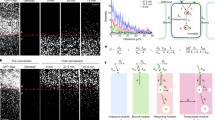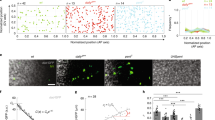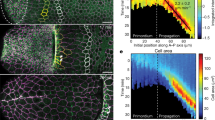Abstract
WHEN Drosophila imaginal disk tissue is cultured in vivo1, the proliferating cells can adopt new fates within the limits of a single disk (‘pattern regulation’2,3) or may even produce structures normally derived from a different disk (‘transdetermination’4). Much of the pattern regulation occurring in imaginal disk fragments may be controlled by interactions between cells that come together during wound healing3,5. I report here further studies on the role of cell interactions in pattern regulation and transdetermination, by means of dissociation and reaggregation of specific disk parts. The data confirm the importance of cell interactions for pattern regulation, and suggest that interactions between cells with large positional disparities may also be crucial for the stimulation of transdetermination.
This is a preview of subscription content, access via your institution
Access options
Subscribe to this journal
Receive 51 print issues and online access
$199.00 per year
only $3.90 per issue
Buy this article
- Purchase on Springer Link
- Instant access to full article PDF
Prices may be subject to local taxes which are calculated during checkout
Similar content being viewed by others
References
Nöthiger, R. in The Biology of Imaginal Disks (eds Ursprung, H. & Nöthiger, R.) 1–34 (Springer, Berlin-Heidelberg-New York, 1972).
Wolpert, L. Curr. Top. devl Biol. 6, 183–224 (1971).
French, V., Bryant, P. J. & Bryant, S. V. Science 193, 969–981 (1976).
Hadorn, E. in Genetic Control of Differentiation. Brookhaven Symp. Biol. 18, 148–161 (1965).
Haynie, J. L. & Bryant, P. J. Nature 259, 659–662 (1976).
Strub, S. Wilhelm Roux Arch. EntwMech. Org. 181, 309–320 (1977).
Garcia-Bellido, A. & Nöthiger, R. Wilhelm Roux Arch. EntwMech. Org. 180, 189–206 (1976).
Strub, S. Wilhelm Roux Arch. EntwMech. Org. 182, 75–92 (1977).
Rose, S. M. Symp. Soc. Stud. Dev. Growth 20, 153–176 (1962)
Strub, S. Wilhelm Roux Arch. EntwMech. Org. 182, 69–74 (1977).
Schubiger, G. Devl Biol. 26, 277–295 (1971).
Adler, P. N. & Bryant, P. J. Devl Biol. (in the press).
Wilcox, M. & Smith, R. J. Devl Biol. (in the press).
Postlethwait, J. H. & Schneiderman, H. A. Devl Biol. 25, 606–640 (1971).
Reinhardt, C. A., Hodgkin, N. M. & Bryant, P. J. Devl Biol. (in the press).
Garcia-Bellido, A. Expl Cell Res. 44, 382–392 (1966).
Tobler, H. J. Embryol. exp. Morphol. 16, 609–633 (1966).
Schubiger, G. Wilhelm Roux Arch. EntwMech. Org. 160, 9–40 (1968).
Lindsley, D. L. & Grell, E. H. Carnegie Inst. Wash. Publ. 627 (1968).
Author information
Authors and Affiliations
Rights and permissions
About this article
Cite this article
STRUB, S. Pattern regulation and transdetermination in Drosophila imaginal leg disk reaggregates. Nature 269, 688–691 (1977). https://doi.org/10.1038/269688a0
Received:
Accepted:
Issue Date:
DOI: https://doi.org/10.1038/269688a0
This article is cited by
-
Extensive regulatory capabilities of a Drosophila imaginal disk blastema
Nature (1981)
-
Transdetermination in leg imaginal discs ofDrosophila melanogaster undDrosophila nigromelanica
Wilhelm Roux's Archives of Developmental Biology (1981)
Comments
By submitting a comment you agree to abide by our Terms and Community Guidelines. If you find something abusive or that does not comply with our terms or guidelines please flag it as inappropriate.



